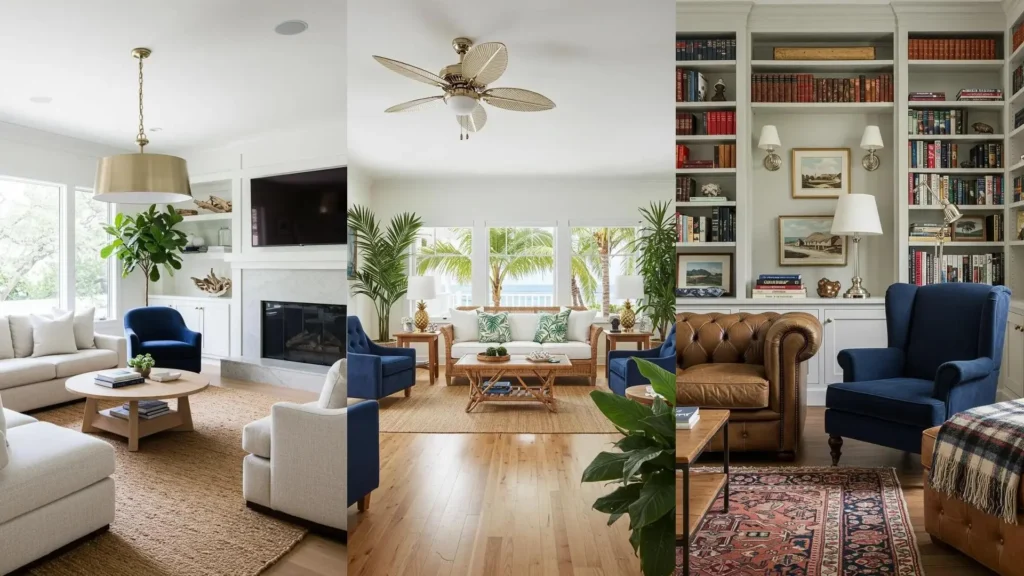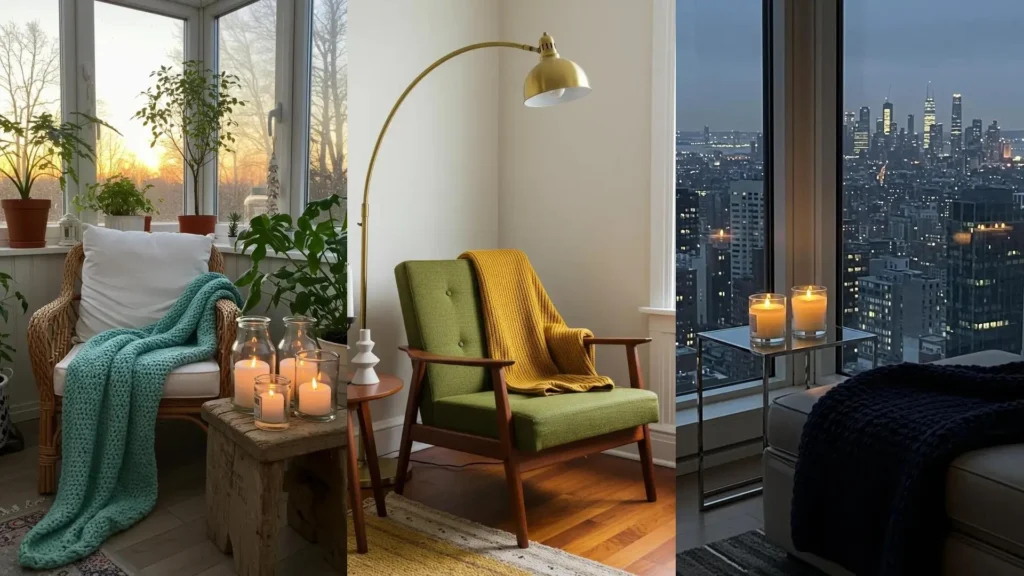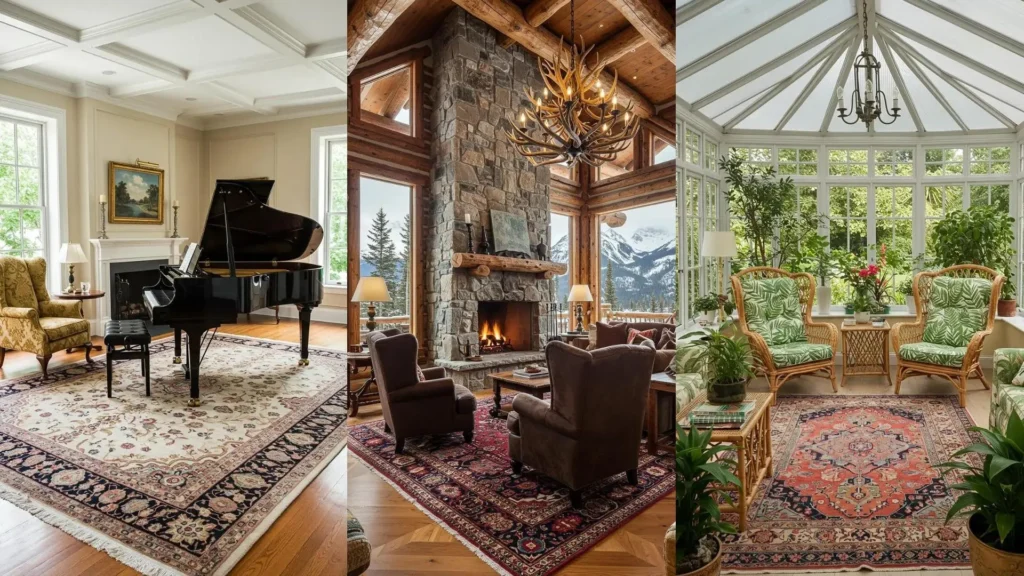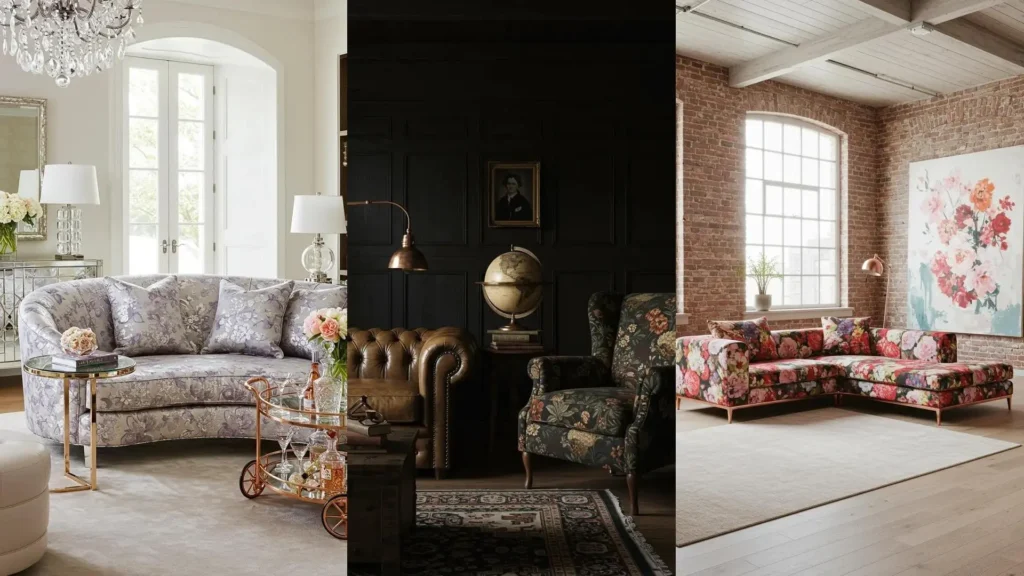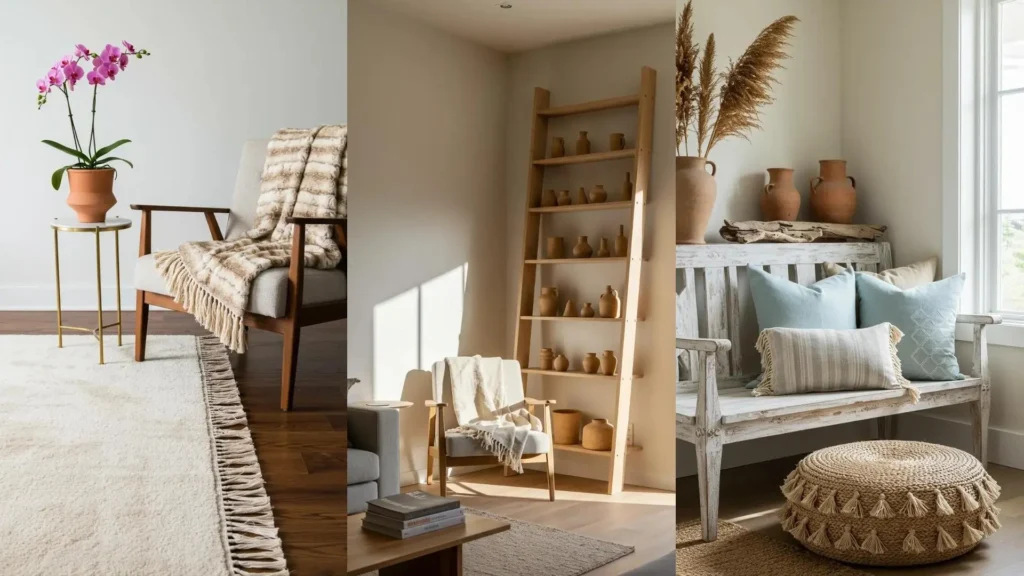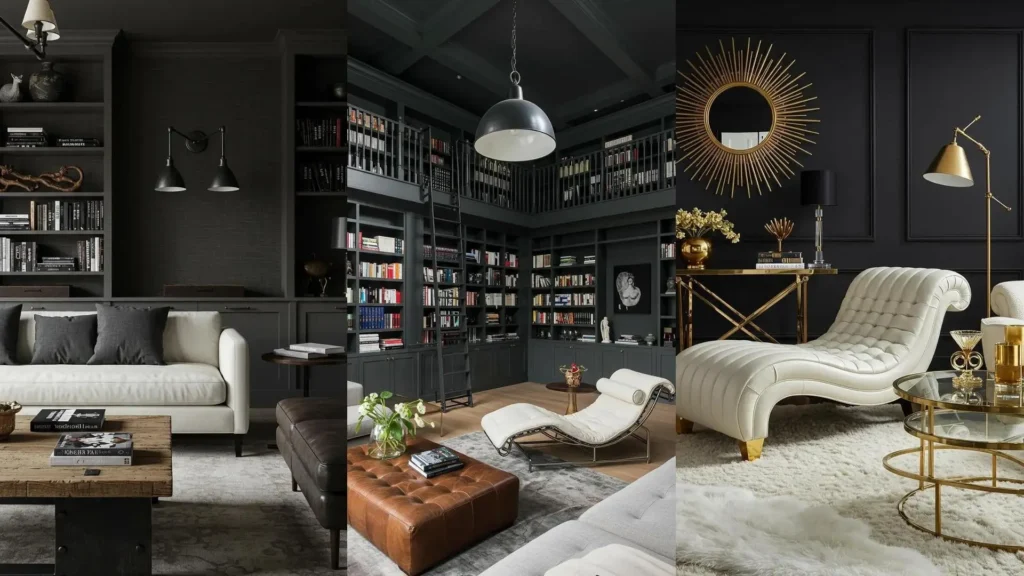Creating a home that feels truly serene isn’t about following a rigid set of rules. It’s about cultivating a feeling of calm, clarity, and quiet joy. This is the essence of Japandi design—a thoughtful blend of Scandinavian comfort and Japanese minimalism.
This philosophy guides you to choose with intention. It favors natural materials that feel good to the touch, layouts that are open and uncluttered, and objects that hold personal meaning or functional beauty. It’s a rejection of fleeting trends in favor of timeless, soulful living.
In the ideas that follow, you won’t find demands for a complete overhaul. Instead, you’ll discover practical, focused adjustments you can make right now—a new way to think about light, a simple shift in texture, or a layout tweak that will help your space breathe. This is your guide to crafting a home that is not just beautiful to look at, but deeply restorative to live in.
1. Frame Your View with Architectural Simplicity

Embrace the calming effect of walls clad in light, unfinished wood to create a warm, seamless envelope for your living space.
Treat a large, minimally framed window not just as a source of light, but as a living piece of art that connects you directly to the outdoors.
Keep your furniture profile low—a deep sofa, a simple console—to preserve the clean sightline and emphasize the sense of openness.
This layout decision allows the natural view and the architecture itself to be the primary focal points.
2. Center Your Space with Soft, Sculptural Light
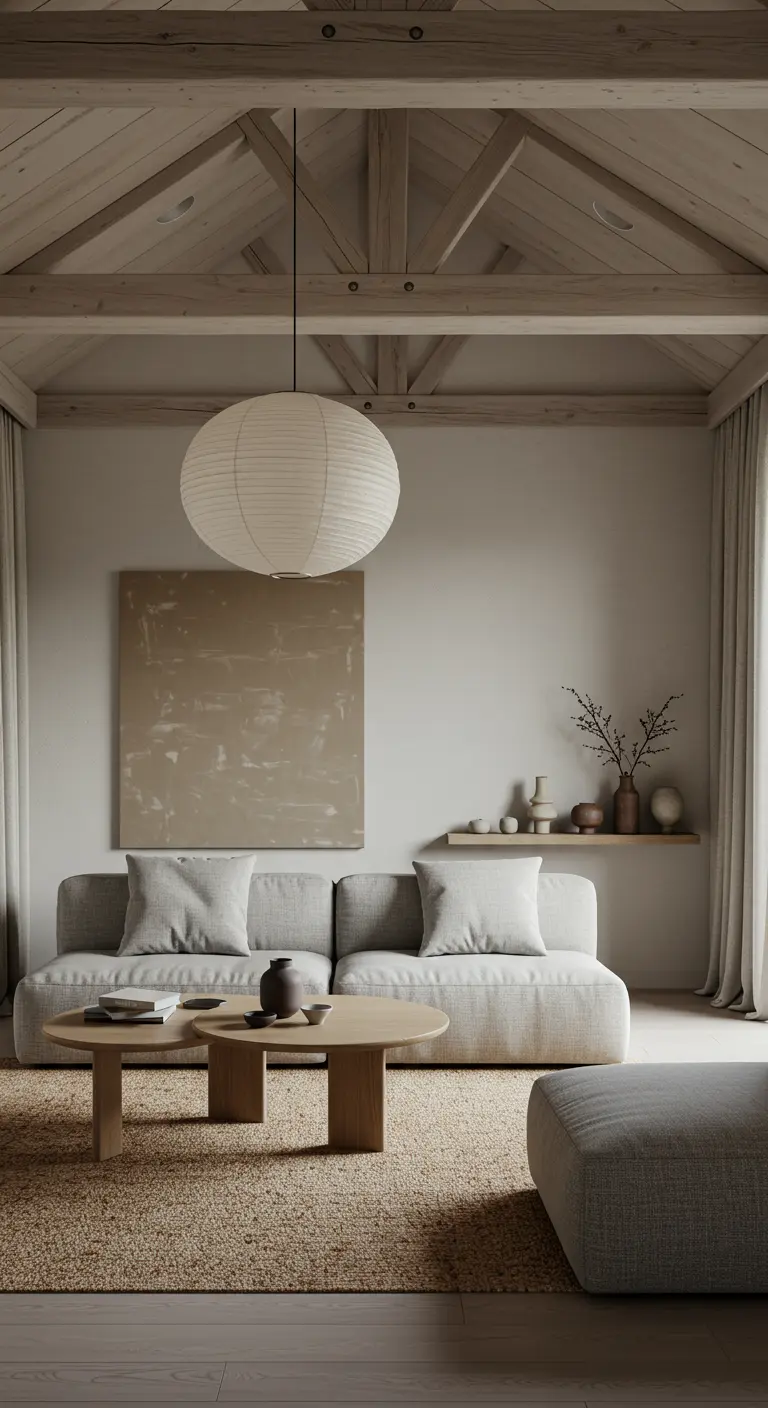
Anchor your room with a single, oversized paper lantern instead of multiple smaller lights.
This classic Japanese element acts as a soft, sculptural focal point, diffusing a warm and gentle glow that eliminates harsh shadows.
In a room with high or vaulted ceilings, it helps to ground the space and make it feel more intimate.
Pair it with a highly textured rug, like jute or sisal, to balance the ethereal quality of the light with an earthy foundation.
3. Embrace Depth with a Monolithic Fireplace
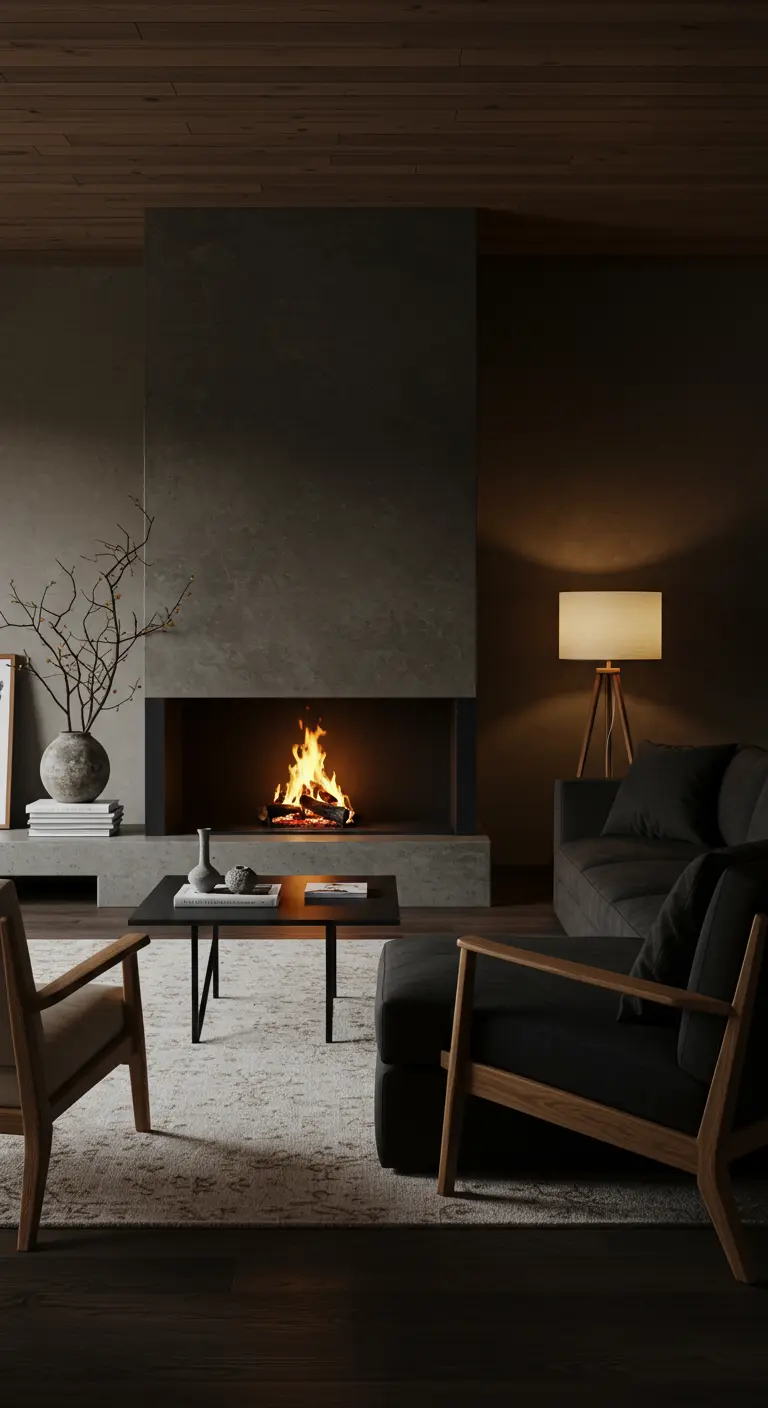
Create a powerful focal point with a clean, monolithic fireplace surround made from concrete or dark plaster.
Its stark simplicity adds architectural weight and a sense of permanence, anchoring the room without any unnecessary ornamentation.
In a darker, moody room, it becomes a hub of warmth and intimacy, inviting you to gather around.
This approach is central to creating quiet luxury interiors, where material and form take precedence over decoration.
4. Define Zones with Traditional Shoji Screens

Use Shoji-style screens to partition your space with grace and flexibility.
Unlike solid walls, their translucent paper allows light to filter through, maintaining a bright and airy feel while creating a sense of separation.
They introduce a beautiful geometric pattern and can be used to hide a workspace or create a cozy reading nook.
This is a foundational concept in Japanese-inspired minimalist design, balancing privacy with openness.
5. Soften the Edges with Floor-to-Ceiling Drapery

Install your curtain rod as high and wide as possible, letting the fabric fall from ceiling to floor.
This technique creates an illusion of height and makes the entire room feel more elegant and unified.
Choose a heavyweight linen or cotton in a soft, neutral color to add a layer of tactile comfort.
Complete the sensory experience by adding a chunky knit throw and dried grasses for varied, natural textures.
6. Filter Light with Natural Woven Blinds
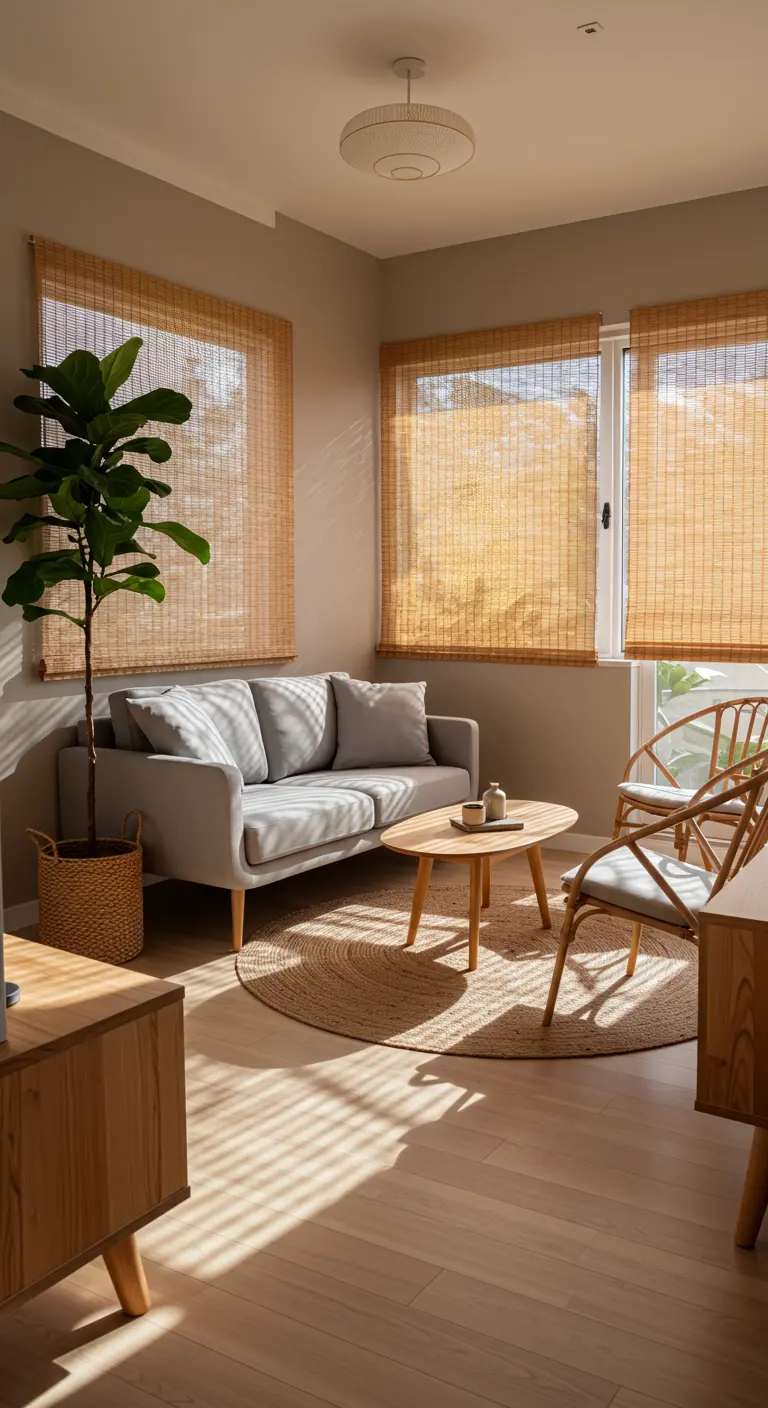
For a lighter alternative to curtains, choose blinds made from natural woven materials like bamboo, jute, or reeds.
They provide privacy while beautifully filtering sunlight, casting warm, linear shadows that add dynamic texture to your walls and floor.
This simple swap instantly connects your interior to the natural world and enhances the feeling of warmth and tranquility.
7. Add Rhythm with a Vertical Slat Wall
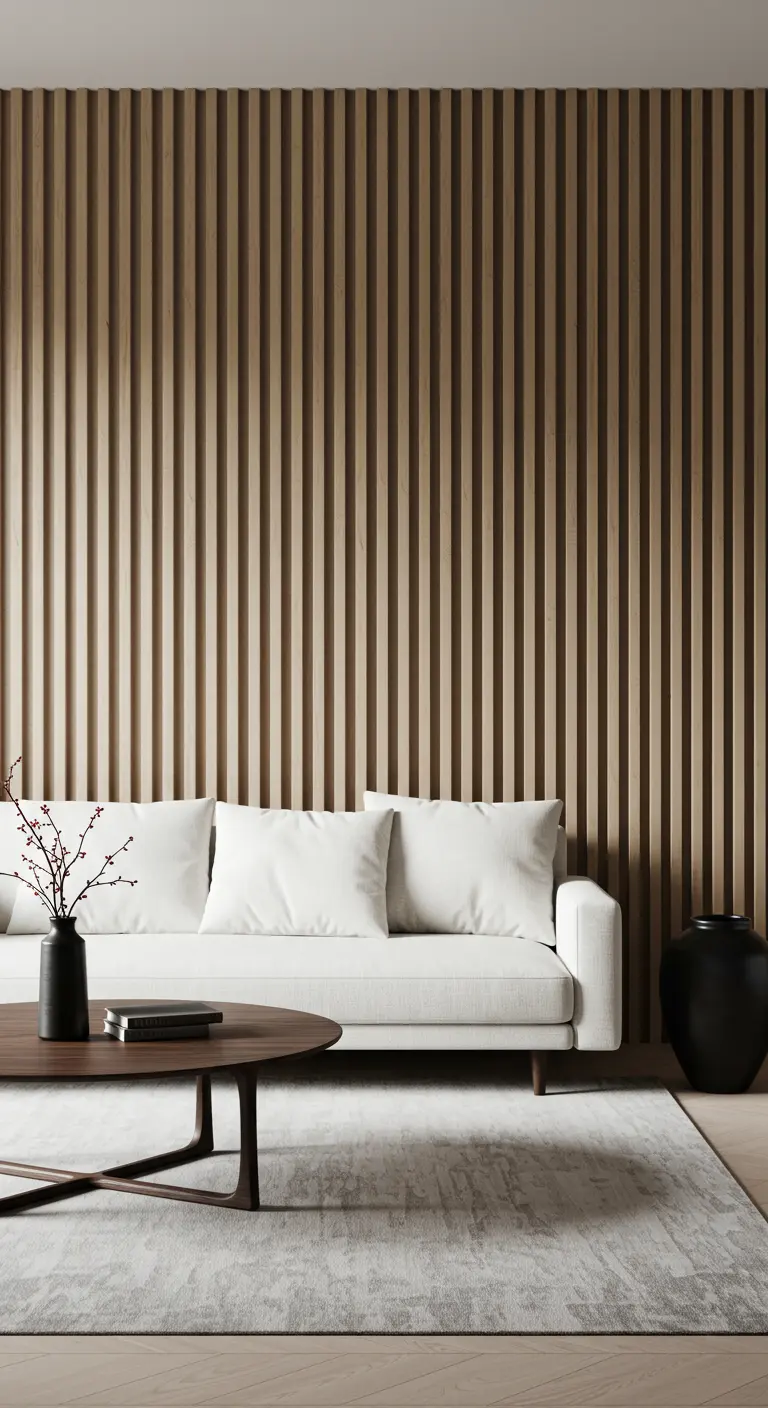
Transform a plain wall into a sophisticated feature with vertical wood slats.
The repetition of the slats adds a calming, rhythmic quality and architectural depth, making the room feel taller and more considered.
It provides a warm, textural backdrop for simple furniture, allowing a crisp white sofa or a dark ceramic accent to truly stand out.
This element is a cornerstone of many modern rustic spaces, blending clean lines with organic material.
8. Introduce Tactile Warmth with Textured Walls
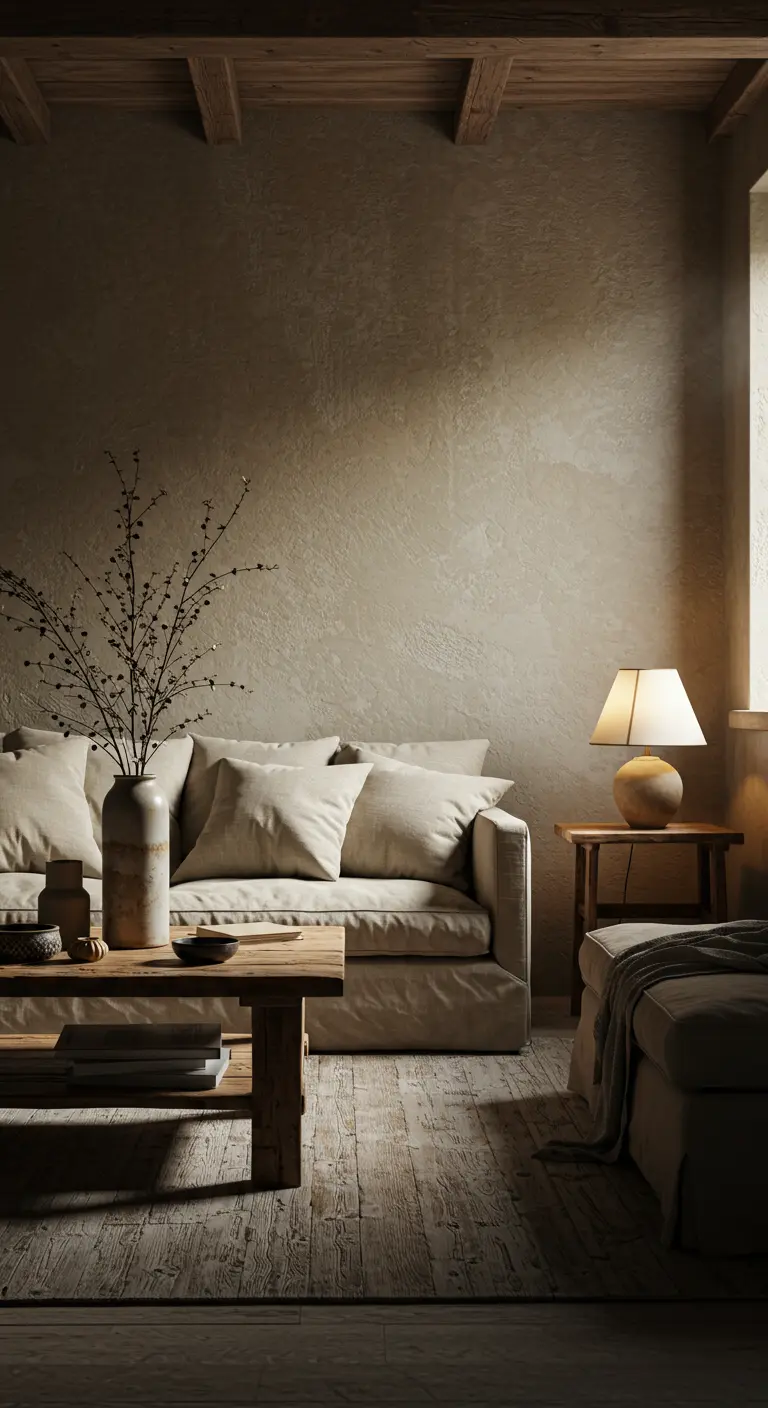
Move beyond flat paint and consider a textured wall finish like limewash or tadelakt.
The subtle variations in tone and texture create a soft, luminous effect, catching the light differently throughout the day.
This organic finish serves as a perfect, gentle backdrop for relaxed linen upholstery and rustic, weathered woods, enhancing the room’s wabi-sabi appeal.
9. Integrate Seating for a Seamless Flow
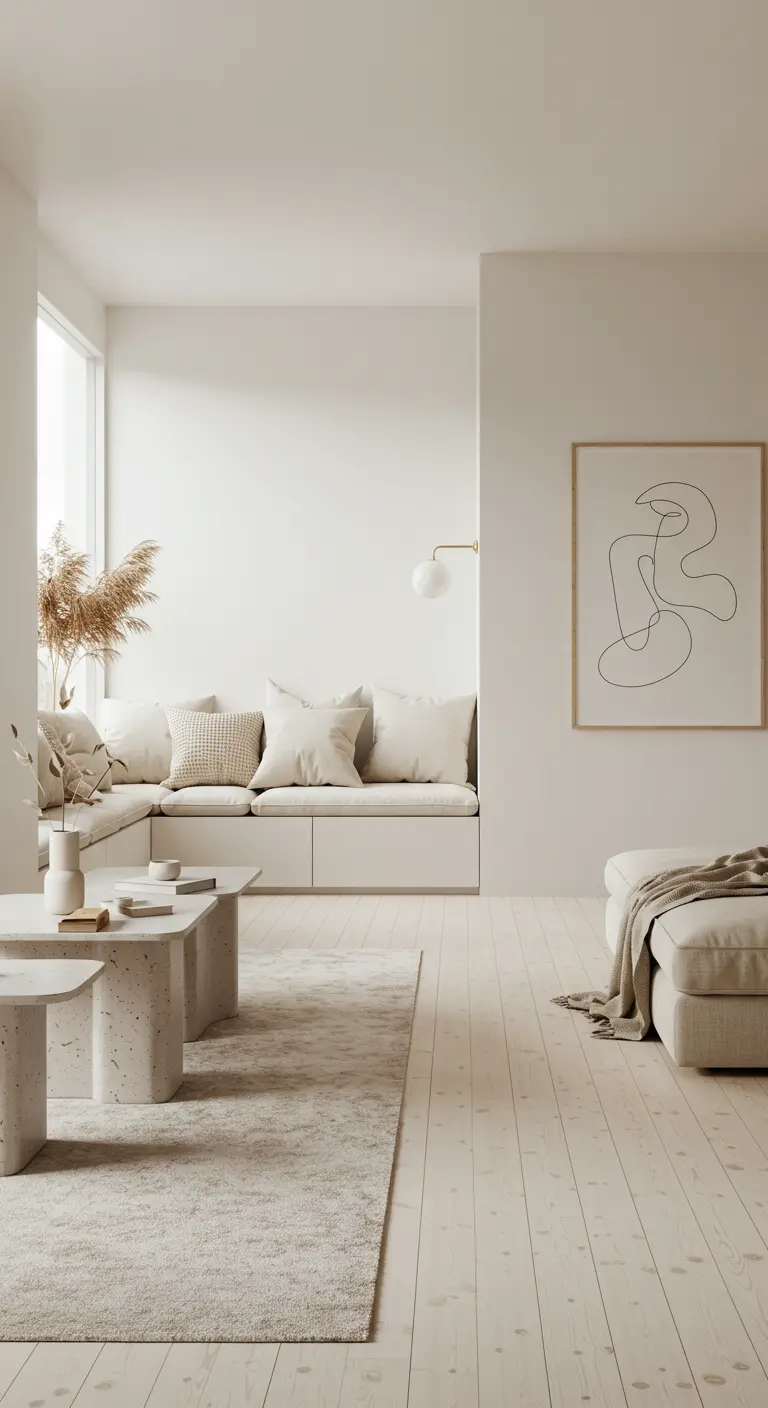
If you’re planning a renovation, consider built-in bench seating to achieve a clean, architectural look.
It maximizes space, provides hidden storage, and creates an uncluttered flow that feels incredibly intentional.
Contrast the simple form of the bench with a sculptural coffee table in terrazzo or concrete for a point of textural interest.
This approach to design is ideal for crafting white-on-white interiors that feel spacious and serene.
10. Ground Your Palette with an Earth-Tone Anchor
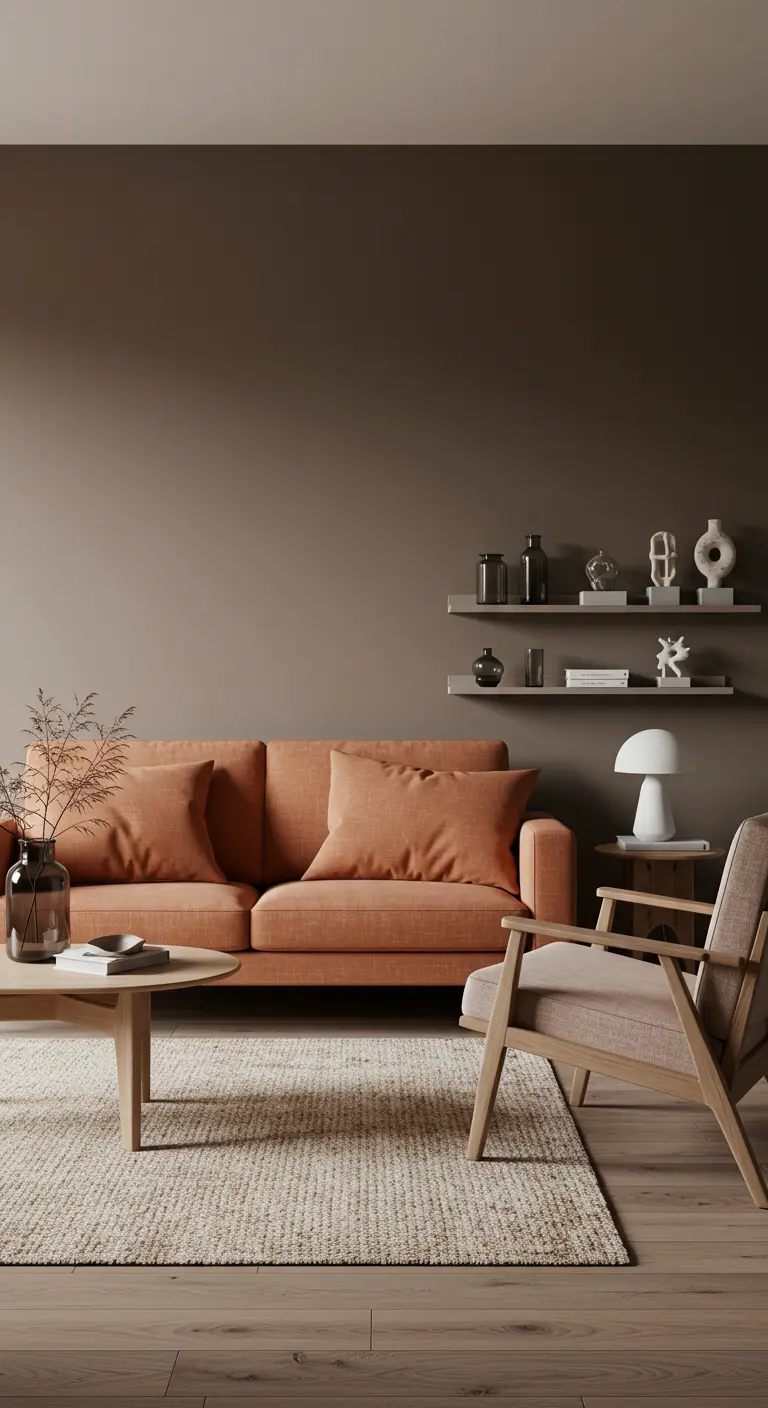
Break up a neutral palette by choosing one significant piece of furniture in a rich, earthy color.
A sofa in a warm terracotta, deep olive, or muted rust hue acts as a confident anchor for the entire room.
Keep the surrounding elements—walls, rugs, and accessories—minimal and subdued to allow this single color to provide all the necessary warmth and personality.
11. Marry Industrial Bones with Soft Textures
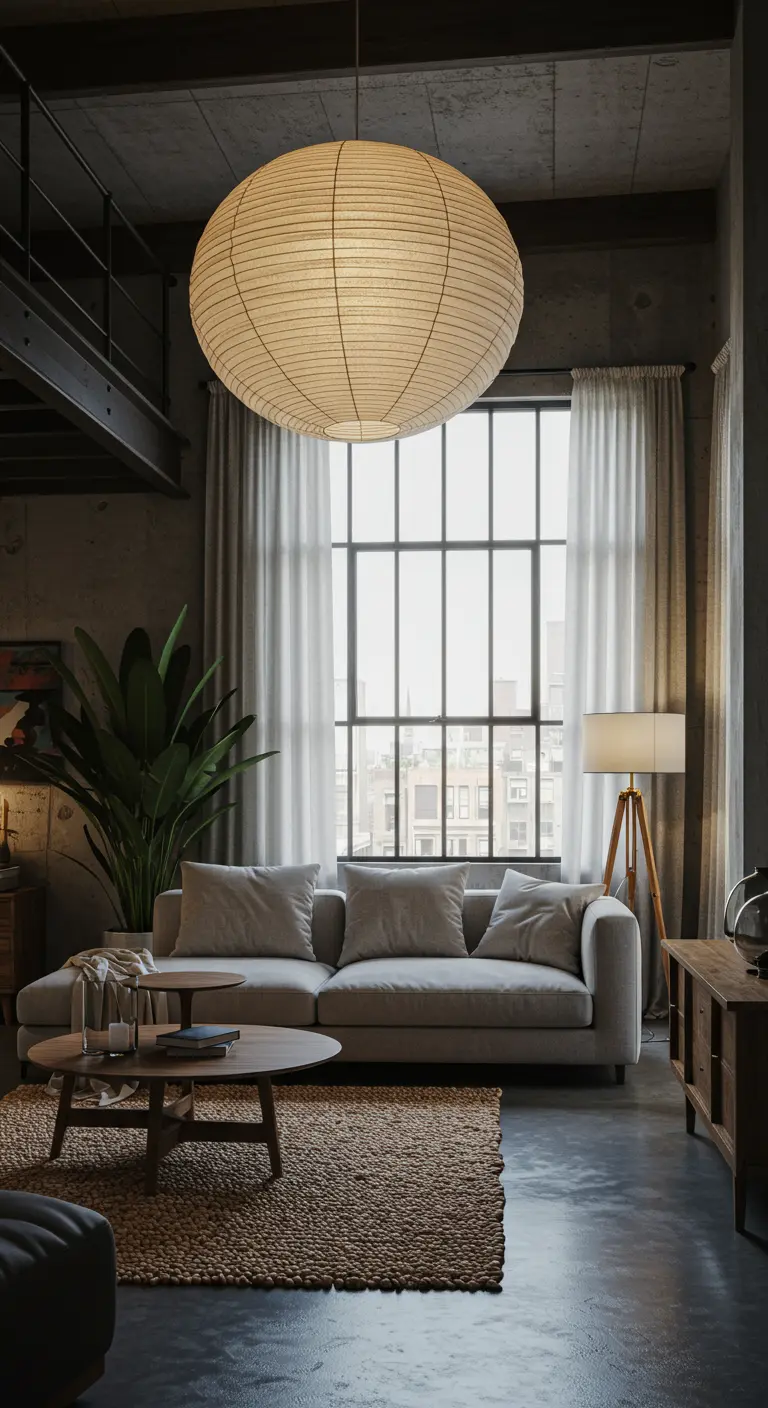
Don’t be discouraged by industrial features like concrete floors or exposed brick.
You can achieve Japandi serenity by layering in intentional softness.
Balance the hard surfaces with a plush, deep-cushioned sofa, a thick jute rug, and an ethereal paper lantern.
This thoughtful contrast is key to transforming urban loft living rooms into cozy, harmonious homes.
12. Create Drama with Concealed Accent Lighting
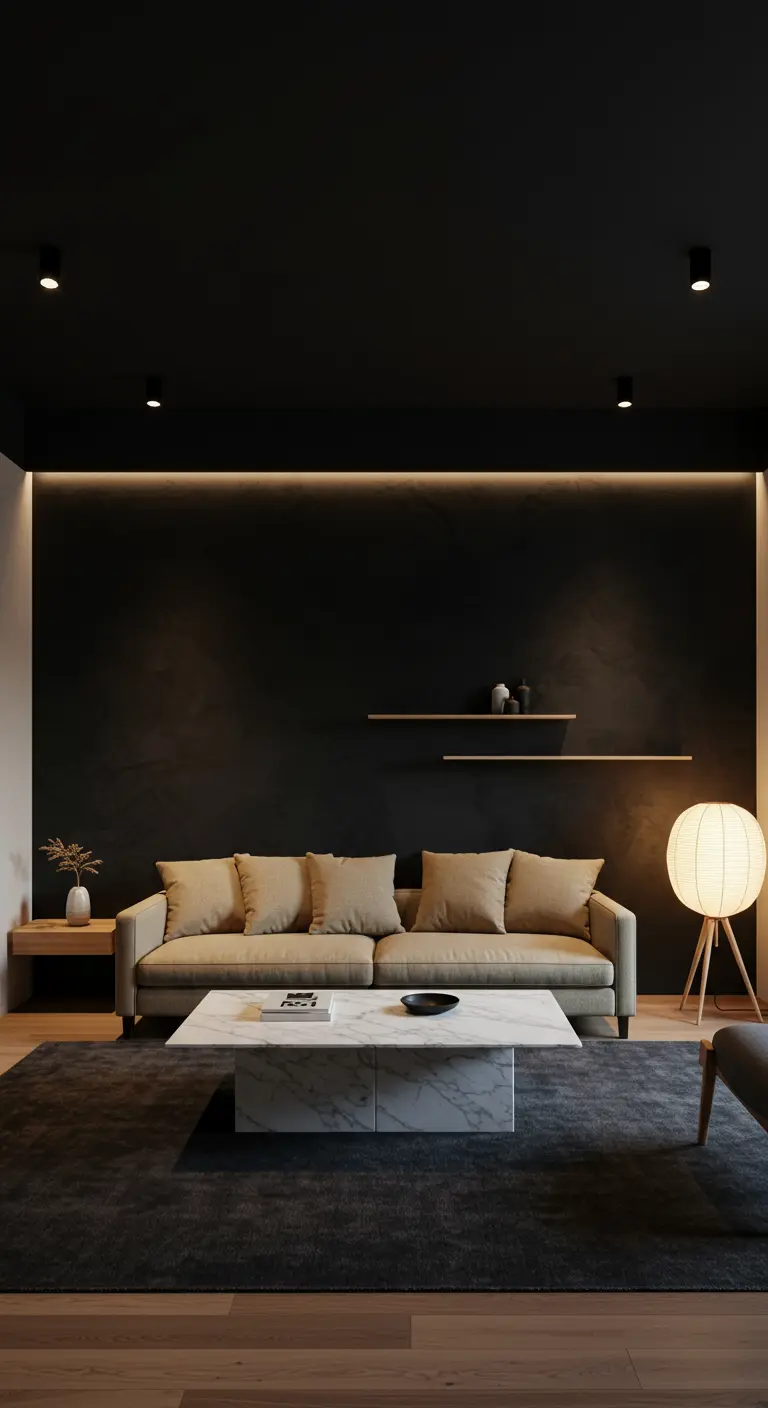
Instead of illuminating a whole room, focus on highlighting specific features.
A concealed LED strip at the top or bottom of a wall—a technique called ‘wall grazing’—can turn a simple surface into a dramatic feature.
It emphasizes the wall’s texture and creates a warm, ambient glow that feels sophisticated and inviting.
It’s one of the most effective stylish lighting tricks to add depth and mood without clutter.
13. Lower Your Perspective for Grounded Living
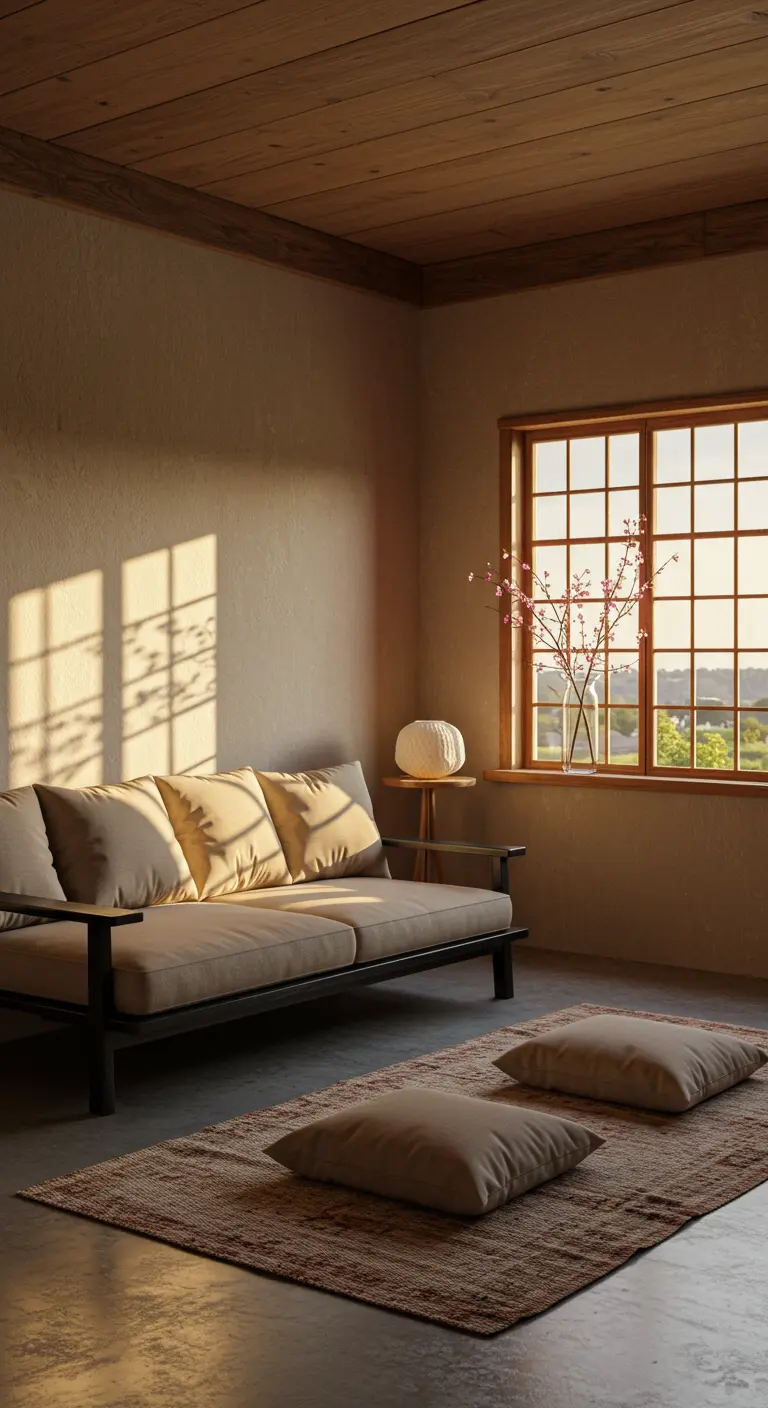
Adopt a key principle of Japanese living by choosing furniture that sits closer to the floor.
A low-profile sofa, a simple platform coffee table, and comfortable floor cushions encourage a more relaxed and mindful way of inhabiting the space.
This approach also makes ceilings feel higher and the room more expansive, a core tenet of Scandinavian-Japanese fusion homes.
14. Cultivate an Indoor Oasis with Rattan and Greenery
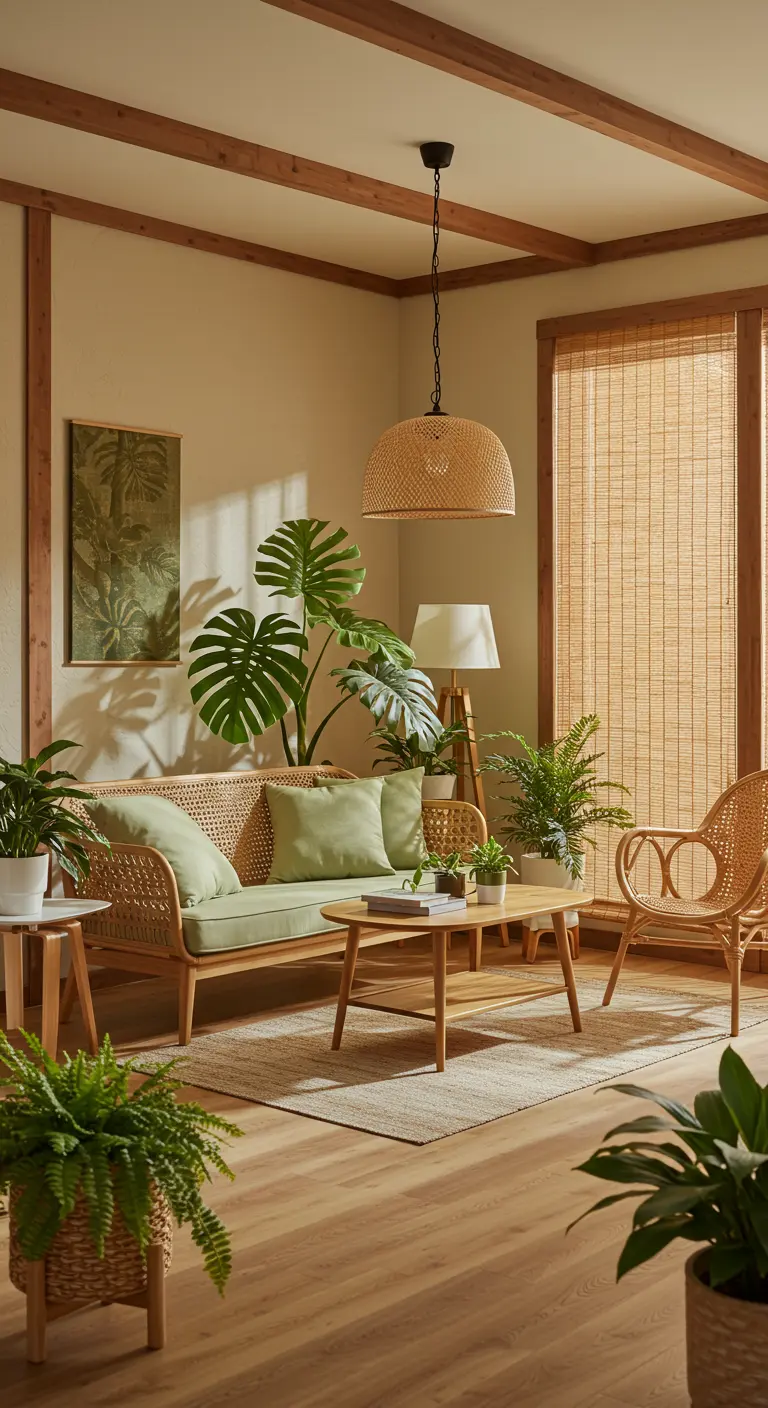
Blur the lines between your home and a garden by making natural elements the focus.
Choose furniture made from light, airy materials like rattan, cane, or wicker, which add texture without visual weight.
Then, layer in a variety of houseplants—from a tall fiddle-leaf fig to a cascading pothos—to add life, color, and purified air.
This combination creates urban jungle living rooms that feel restorative and vibrant.
15. Design a Niche for a Moment of Contemplation
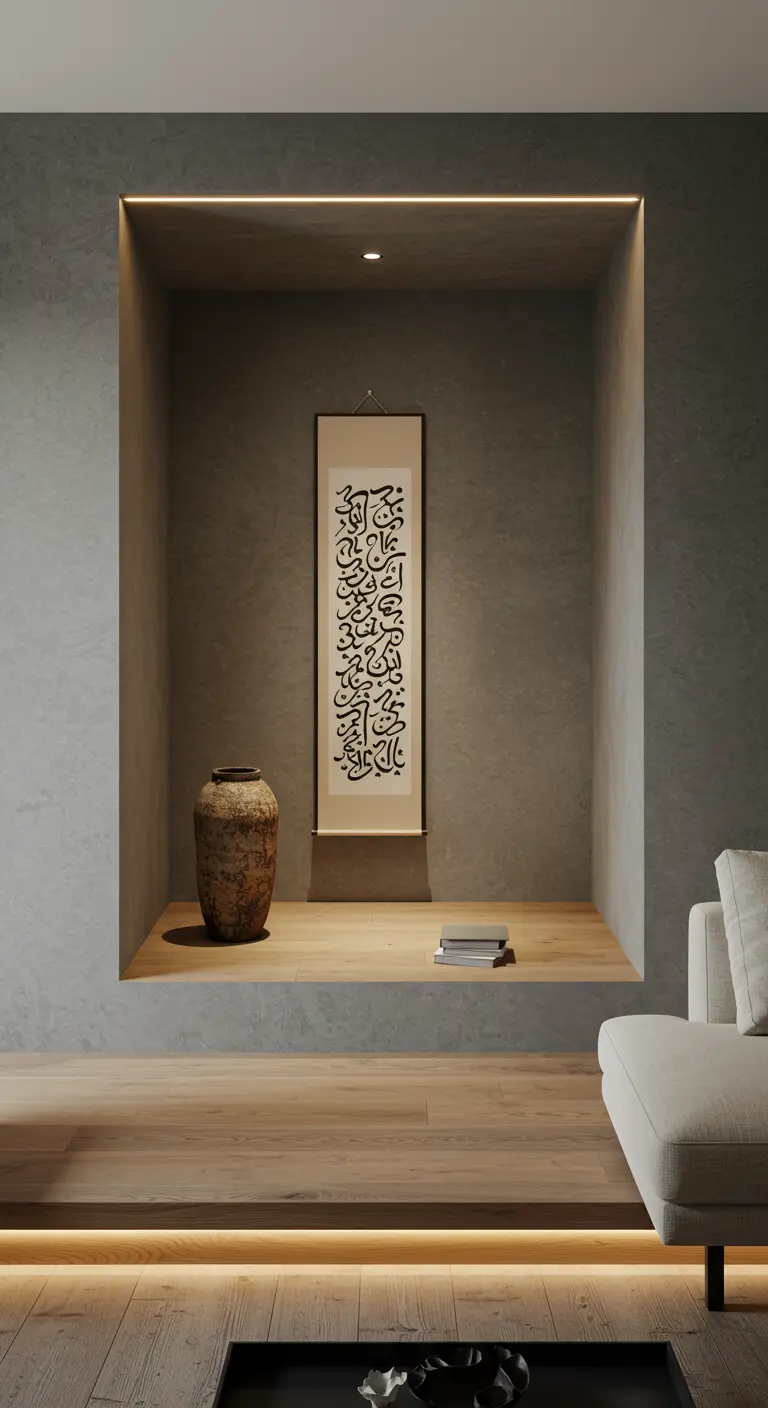
Carve out a dedicated display niche, known in Japanese architecture as a ‘tokonoma’, to create a powerful focal point.
Resist the urge to fill it. Instead, select a single, meaningful object—a sculptural vase, a beautiful rock, or a piece of art.
Illuminate it with a single, focused spotlight to elevate its importance and invite quiet appreciation.
16. Mix Mid-Century Icons with a Moody Palette
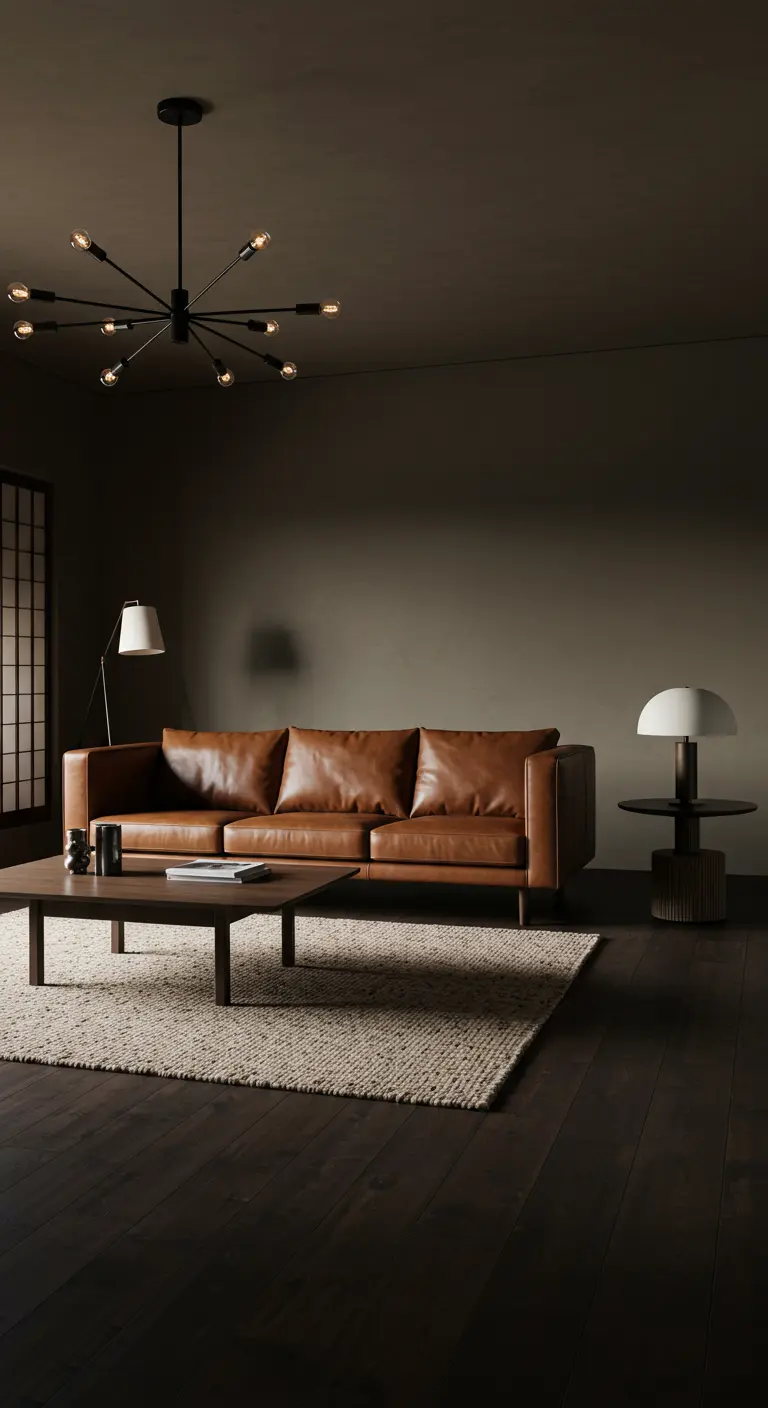
Japandi design harmonizes beautifully with the clean lines and warm woods of Mid-Century Modernism.
Pair a timeless piece, like a cognac leather sofa or a sculptural armchair, against a backdrop of dark, moody walls in charcoal or deep olive.
Add a statement light fixture, like a sputnik chandelier, to bridge the two styles with confidence.
These are the kinds of sophisticated mid-century modern rooms that feel both curated and comfortable.
17. Conceal Clutter with Seamless, Integrated Storage

The foundation of a serene Japandi home is a commitment to organization.
Invest in floor-to-ceiling storage with flat, handleless doors. This solution blends into the wall, reading as an architectural feature rather than bulky furniture.
It allows you to keep everyday clutter out of sight, preserving a sense of calm and order.
This is one of the most effective ways to define spaces in small apartments and maximize peace.
18. Capture a Coastal Feeling with Light and Weave

Adapt the Japandi aesthetic for a coastal setting by emphasizing light and airiness.
Use sheer, breezy curtains to diffuse sunlight softly throughout the room.
Choose furniture that features woven details, such as a webbed strap armchair or a cane-fronted cabinet.
A natural jute rug and accents of soft blue or sea glass green will complete the look, reminiscent of a relaxed coastal farmhouse.
19. Erase the Boundary Between Indoors and Out
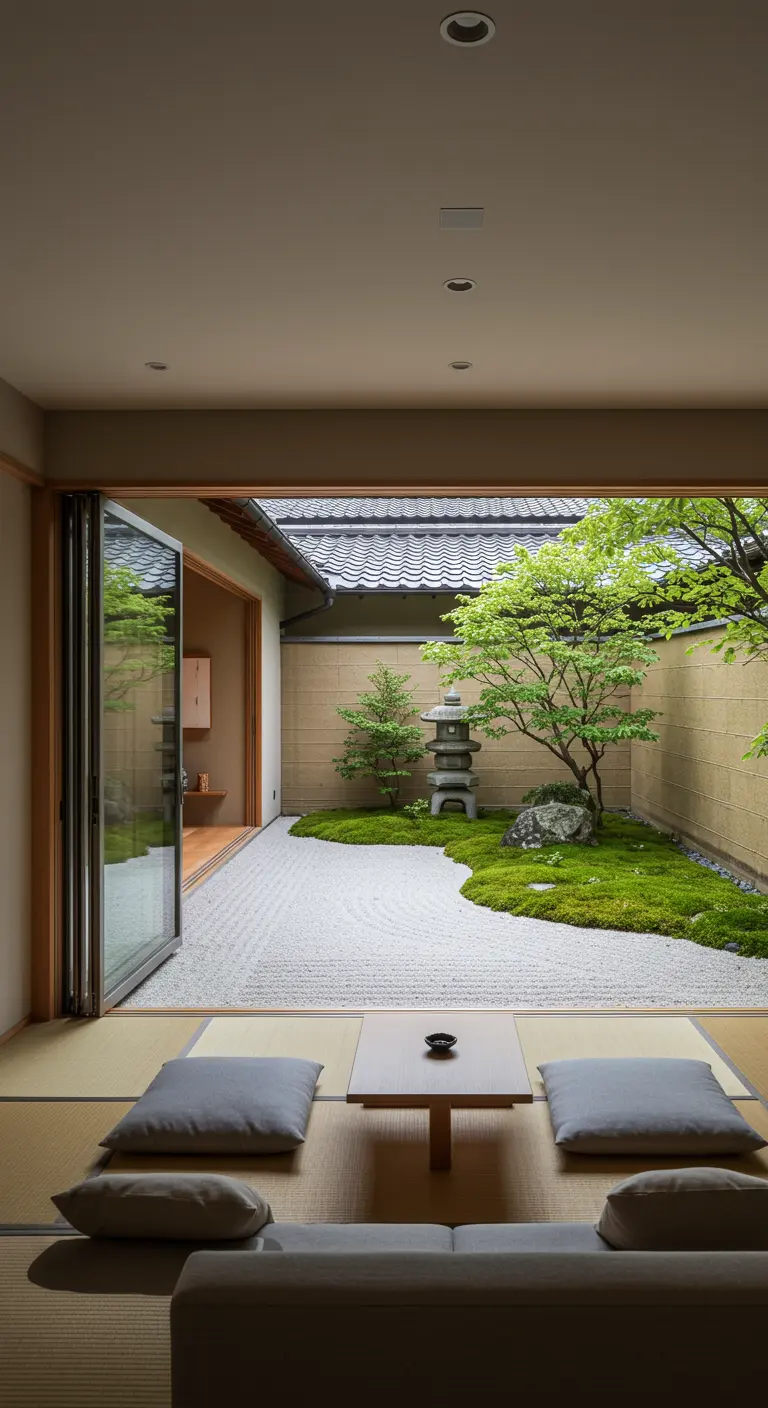
If your home allows, install bifold or sliding glass doors that open completely to a garden or patio.
This act of dissolving the wall makes nature the most important element of your decor, extending your living space and flooding it with fresh air.
Complement the effect with natural flooring like tatami mats or a simple sisal rug to enhance the seamless transition.
20. Play with Geometry in a Monochromatic Scheme
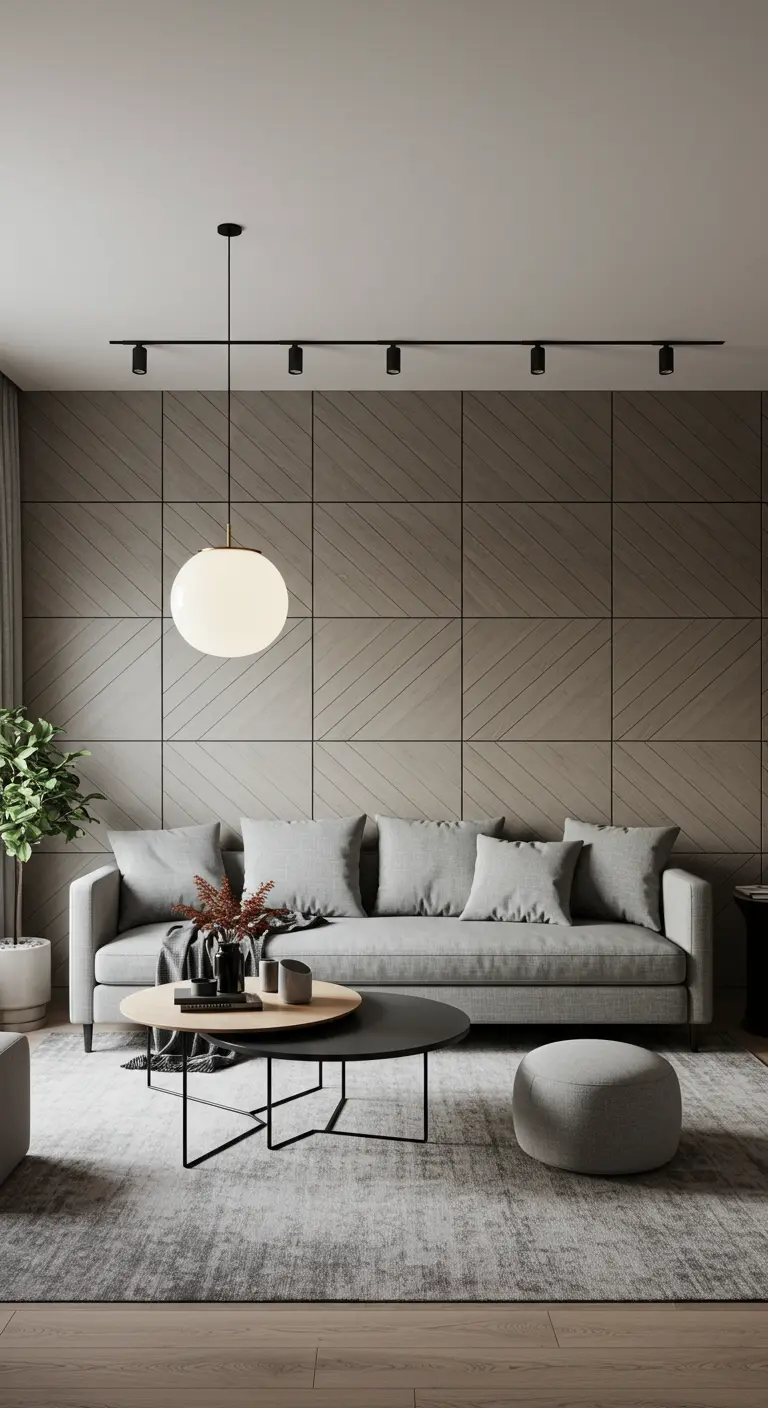
A neutral, monochromatic room can be deeply interesting if you play with texture and pattern.
Install large-scale wall panels with subtle geometric grooves to add visual rhythm without introducing color.
Use modern track lighting to precisely illuminate art or seating areas, and add a single, contrasting shape—like a soft globe pendant—to break up the linear forms.
21. Layer Textures for a Rich, Sensory Experience
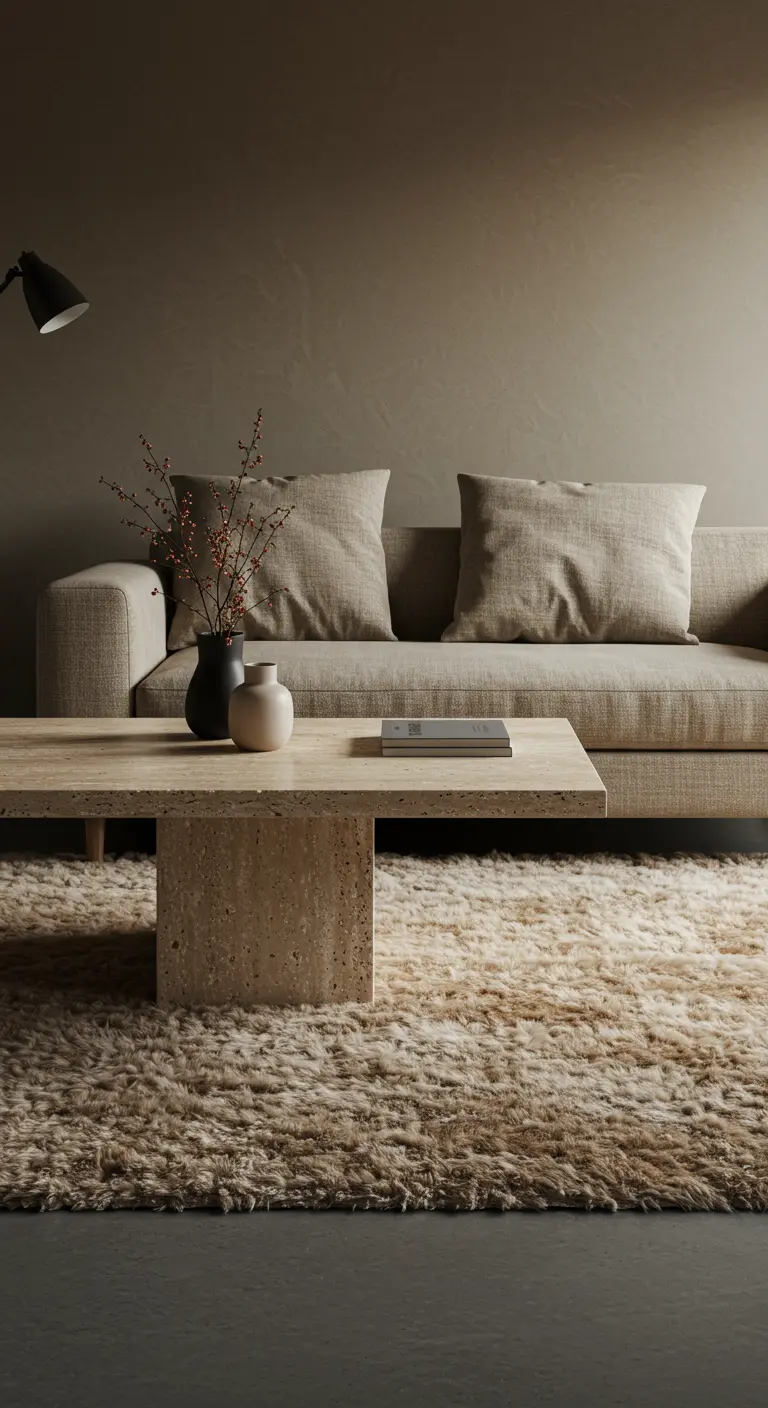
A truly successful minimalist space engages more than just the eyes; it engages the sense of touch.
Create a rich sensory landscape by layering diverse textures.
Contrast the deep, plush pile of a wool shag rug against the cool, smooth surface of a travertine or marble coffee table.
Add the final layer with the soft, rumpled comfort of a linen sofa—an invitation to slow down and relax.
22. Introduce Character with Antique-Inspired Elements
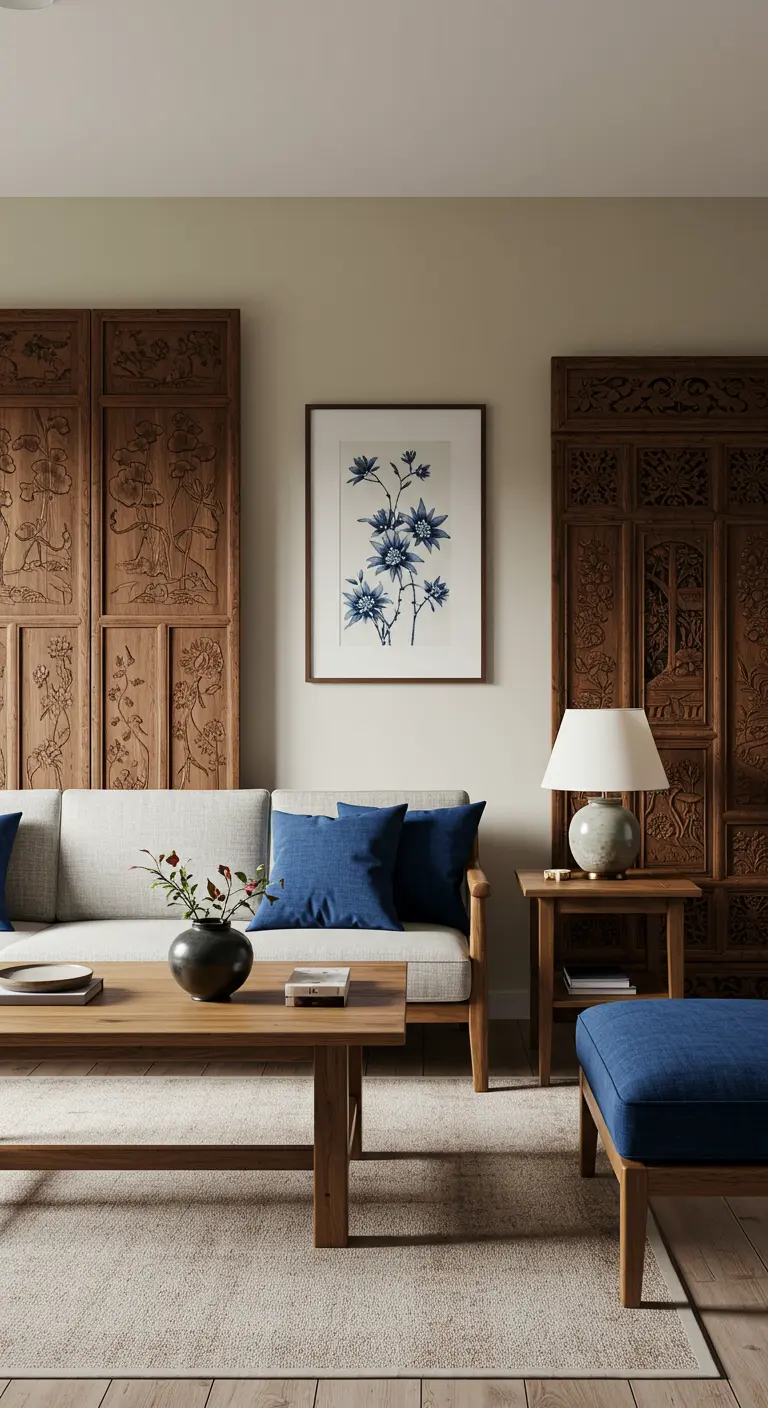
Prevent a minimalist space from feeling sterile by incorporating pieces with history and soul.
Intricately carved wooden screens, whether antique or replicas, provide a stunning, textural contrast to clean, modern furniture.
Ground the look with a classic color, like a deep cobalt blue, in your textiles and tie it together with simple, framed botanical prints.
23. Create an Atmosphere with Scattered Floor Lanterns

Rethink your lighting strategy by bringing the light source down to a human level.
Instead of relying only on ceiling fixtures, scatter paper lanterns of varying sizes across the floor.
This simple act transforms a room, creating an intimate, magical atmosphere with soft pools of warm light.
It’s an especially effective technique for making large, rustic rooms with high ceilings feel cozy, but it also works for evening wedding decor.

